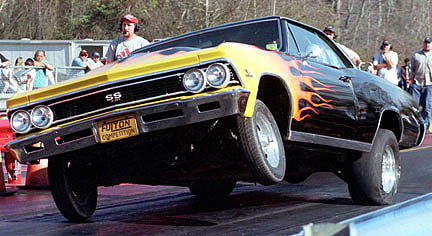Rear Wheel Drive
Rear wheel drive, abbreviated RWD, was the first method used to get power from
the transmission to the tires. The first mass produced rear wheel drive car was
the Curved Dash Olds, in 1901. The system was easy to produce and was used in
all of Henry Ford's early automobiles as well. Much later, the power created by
the large engines manufactured in the late 1960s and early 1970s (or classic
muscle age) required extra strength, as the smaller drive shafts and axles of
the previous years would  break under the stress. Only the simplicity of the rear wheel drive system
allowed to the ability to make the components larger and hence stronger and
more durable, as room for those components is far more limited in
front wheel drive vehicles.
break under the stress. Only the simplicity of the rear wheel drive system
allowed to the ability to make the components larger and hence stronger and
more durable, as room for those components is far more limited in
front wheel drive vehicles.
Due to the fact that more materials are required to produce a typical rear wheel
drive system, production costs and overall weights are higher, thus the
popularity of rear wheel drive vehicles all but faded out in the economical and
small car market when the front wheel drive systems
were developed. The performance gains from rear wheel drive systems were not
forgotten, though, and many new performance car and truck models feature it.
Owners of nicer rear wheel drive vehicles often customize them to have even
better performance with wider tires and lower vehicle stances. The wider tire
creates a larger footprint on the ground, which works well to spread out the
engines power over the road, creating more traction. Changing a vehicles
suspension to lower its stance makes the car have a lower center of gravity, as
well as improving the aerodynamics of the car. For that reason police cars are
often rear wheel drive and are slightly lowered, due to the handling benefits
at high speed.
Rear wheel drive systems have special benefits that do not occur in front wheel
drive cars. First, rear wheel drive cars tend to have more balanced weight,
since the differential in the rear of the car counteracts the heaviness of the
engine being in the front. This makes the weight more evenly spread over the
tires, creating more overall road stability in dry conditions.  Another benefit is the ability to over-steer, or drift. When an experienced
driver performs a drift, the rear wheels break free and spin around the front
tires, allowing the car to turn much sharper at high speeds than a comparable
front wheel drive car. Takeoff on dry surfaces is far better in rear
wheel drive cars as well, since on acceleration weight is "shifted" to the rear
of the car, creating a larger force from the tires to the ground.
Another benefit is the ability to over-steer, or drift. When an experienced
driver performs a drift, the rear wheels break free and spin around the front
tires, allowing the car to turn much sharper at high speeds than a comparable
front wheel drive car. Takeoff on dry surfaces is far better in rear
wheel drive cars as well, since on acceleration weight is "shifted" to the rear
of the car, creating a larger force from the tires to the ground.
Rear wheel drive systems do not outperform front wheel
drive systems in all ways though. Since the center of mass of the car
is pushed by the rear wheels at a distance instead of being pulled, the
horizontal stability of a rear wheel drive system is significantly less when
the rear tires break loose, particularly on slick surfaces. This can easily
lead to an accident if a driver is inexperienced and loses control of the
vehicle, causing it to spin around. Another disadvantage of rear wheel drive is
takeoff in wet or slippery conditions. If the tires break free on takeoff, the
weight isn't "shifted" to the rear as it is in dry conditions, meaning the
weight that usually goes towards traction instead needs to be pushed to get
going. Front wheel drive cars keep that weight up front with the driving
wheels, making traction on slick surfaces typically much better. The best of
both worlds though, lies in four wheel drive systems.
<- Front Wheel Drive Four
Wheel Drive ->
Russell Gillmore 2004
 break under the stress. Only the simplicity of the rear wheel drive system
allowed to the ability to make the components larger and hence stronger and
more durable, as room for those components is far more limited in
front wheel drive vehicles.
break under the stress. Only the simplicity of the rear wheel drive system
allowed to the ability to make the components larger and hence stronger and
more durable, as room for those components is far more limited in
front wheel drive vehicles.
 Another benefit is the ability to over-steer, or drift. When an experienced
driver performs a drift, the rear wheels break free and spin around the front
tires, allowing the car to turn much sharper at high speeds than a comparable
Another benefit is the ability to over-steer, or drift. When an experienced
driver performs a drift, the rear wheels break free and spin around the front
tires, allowing the car to turn much sharper at high speeds than a comparable